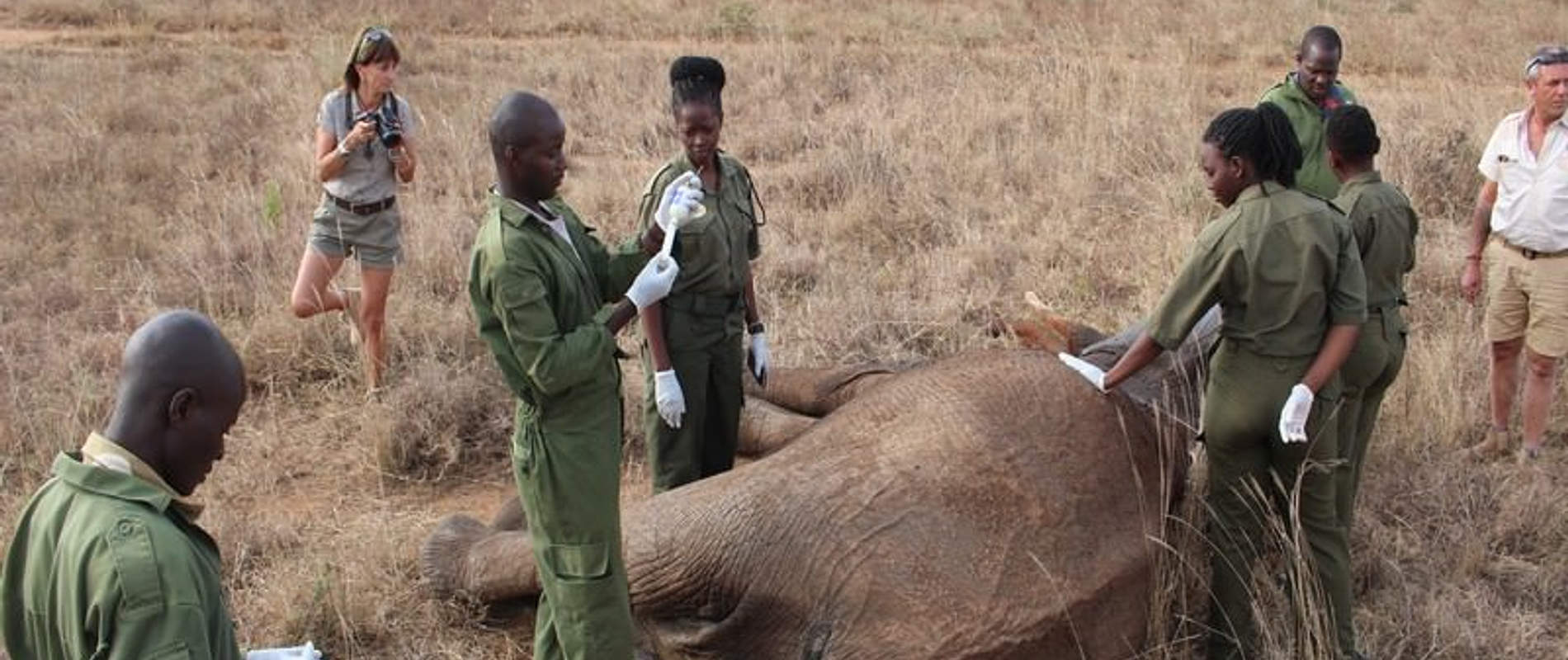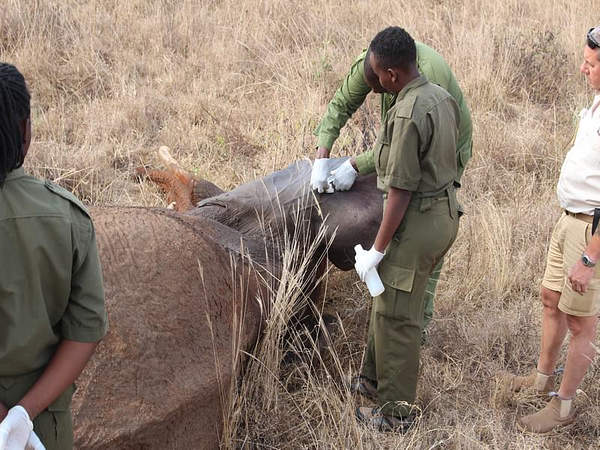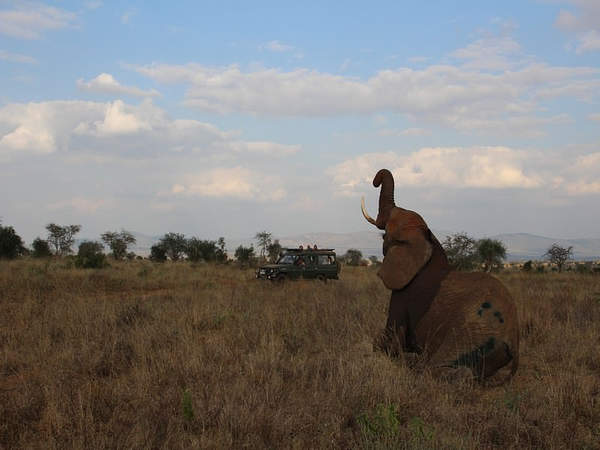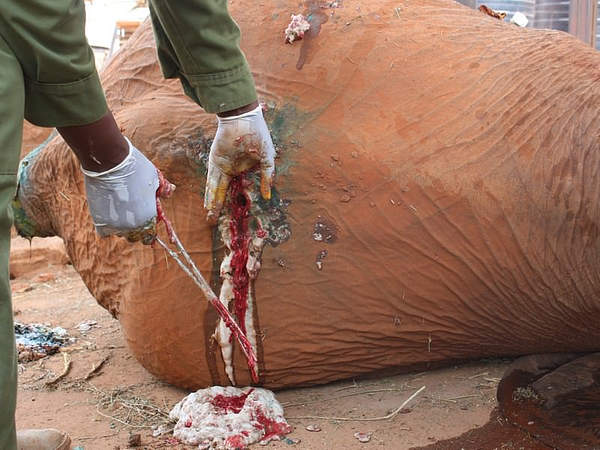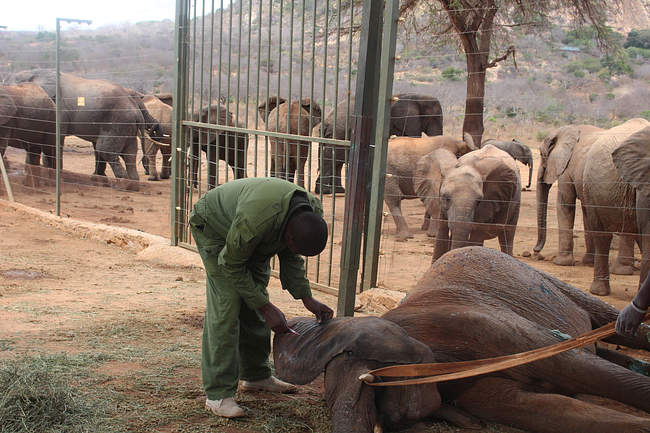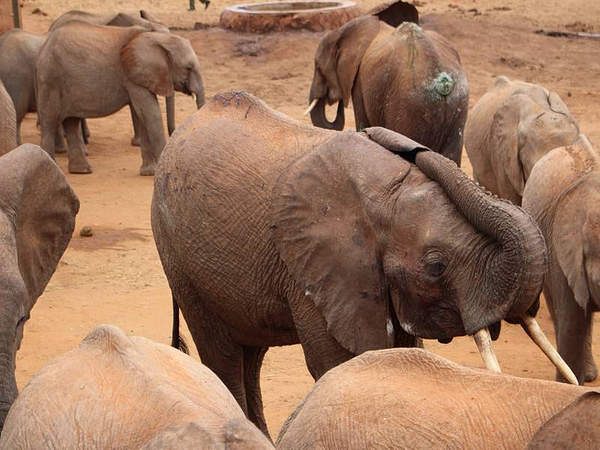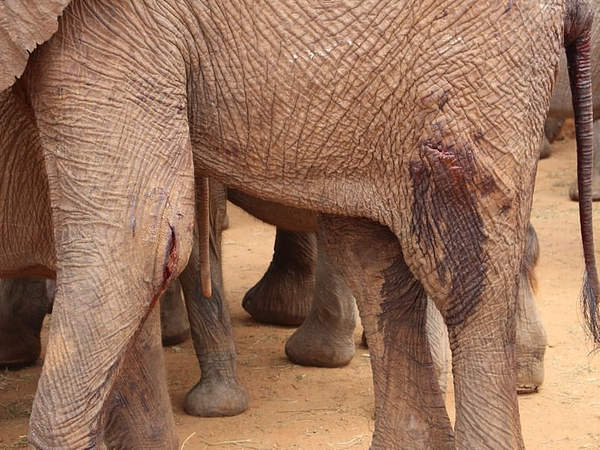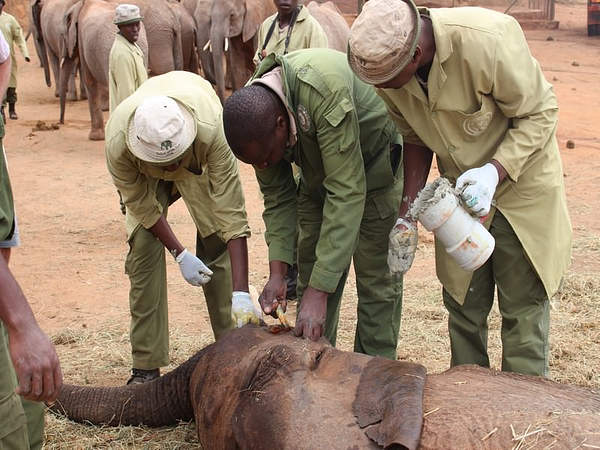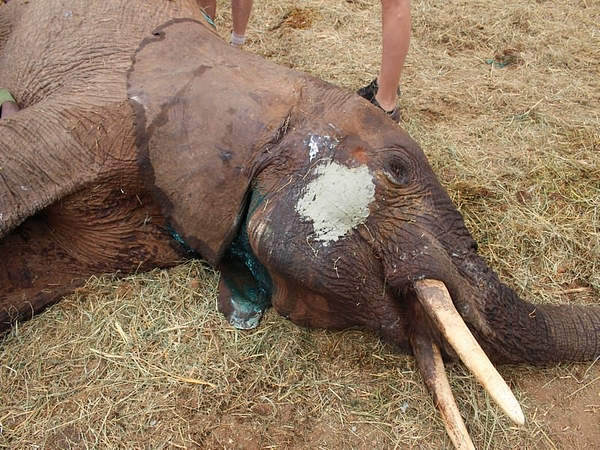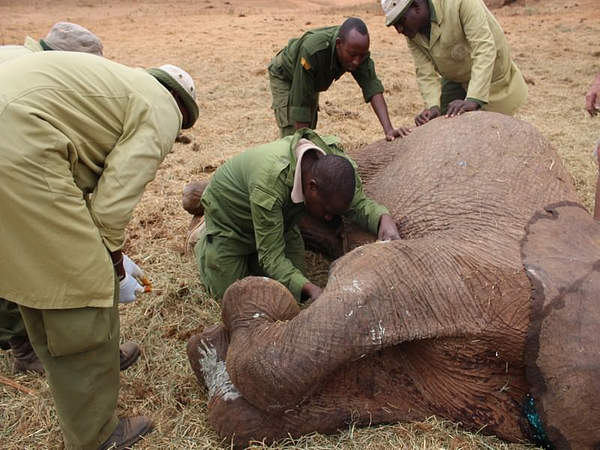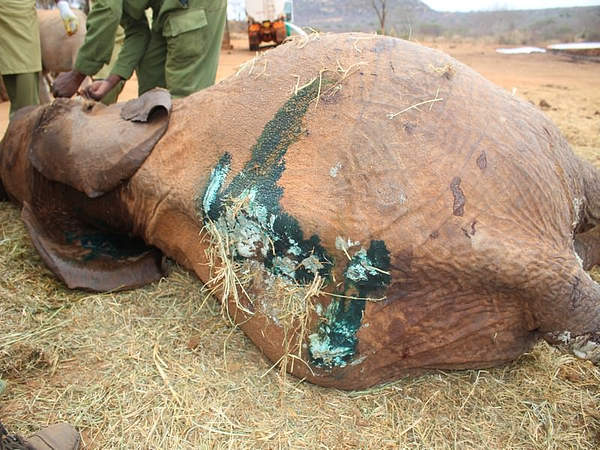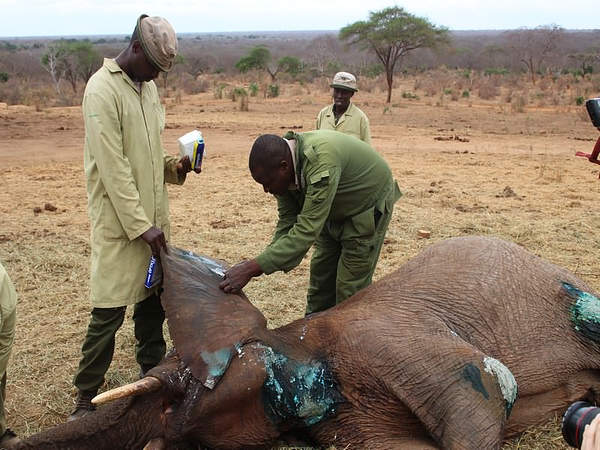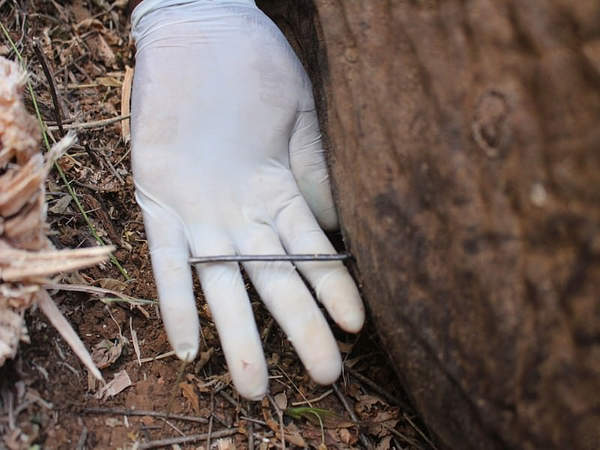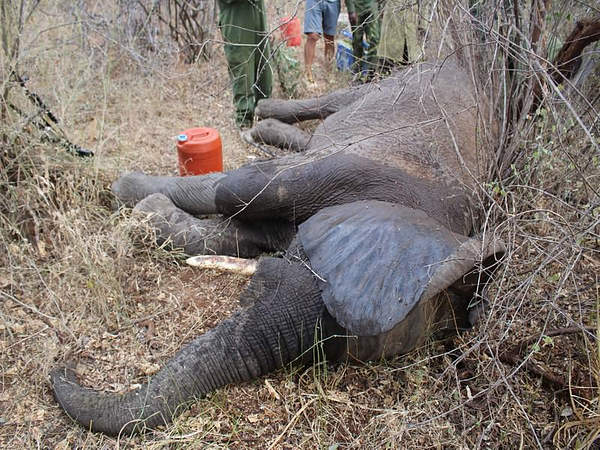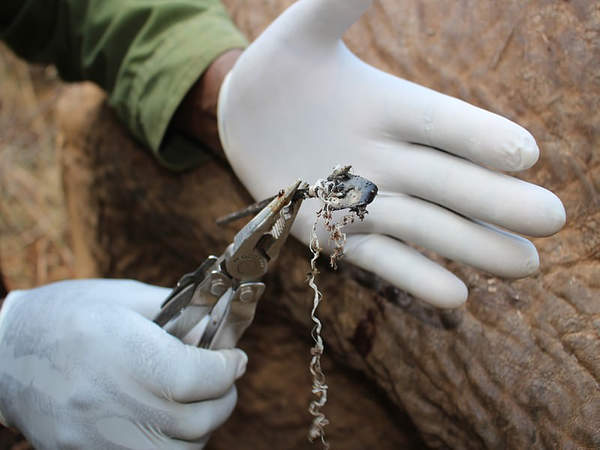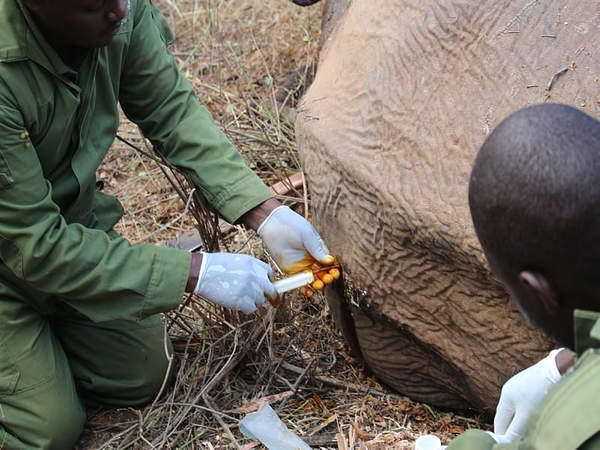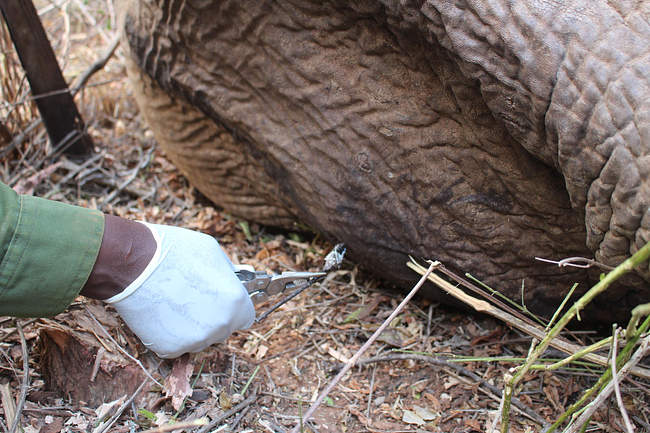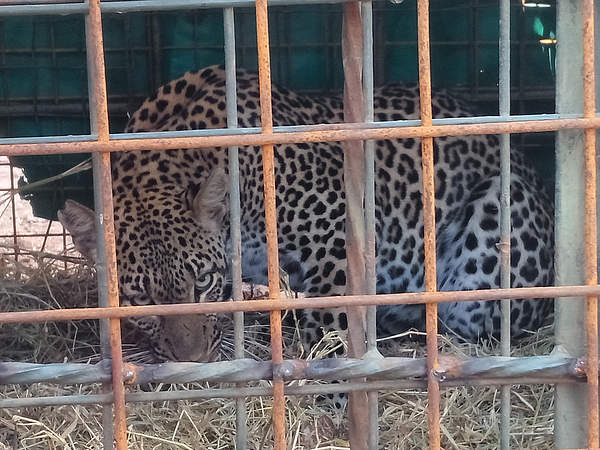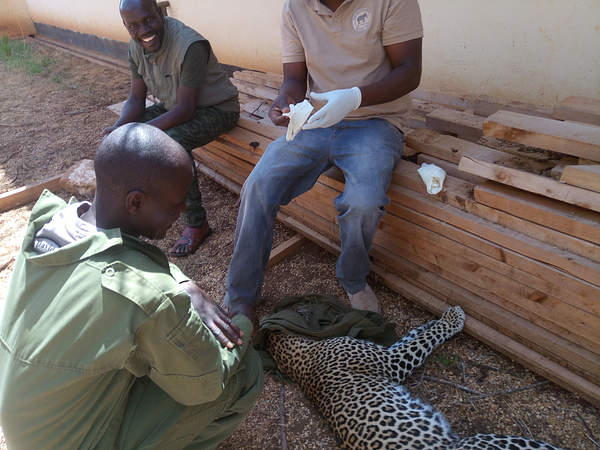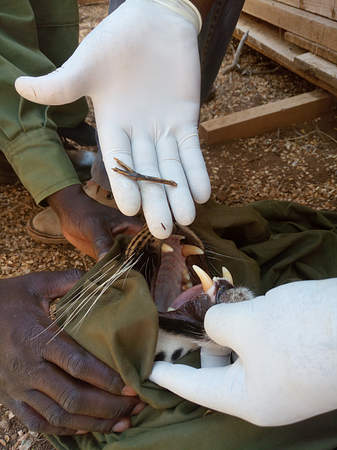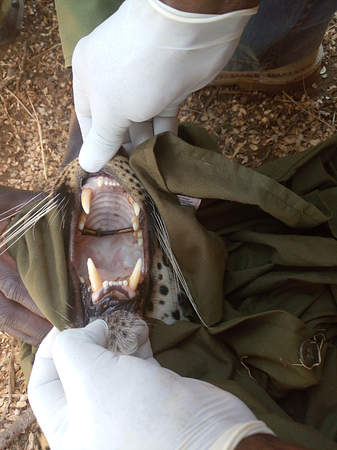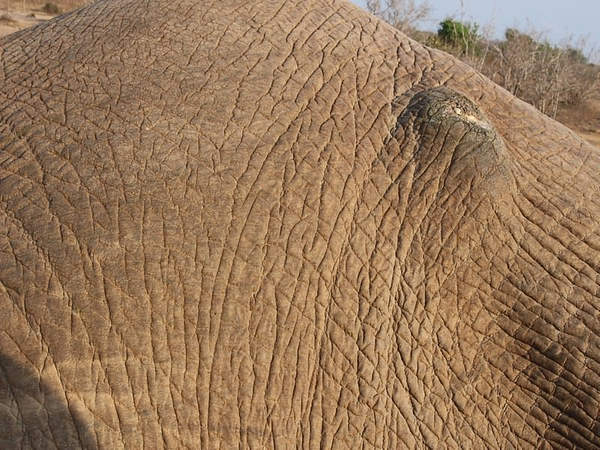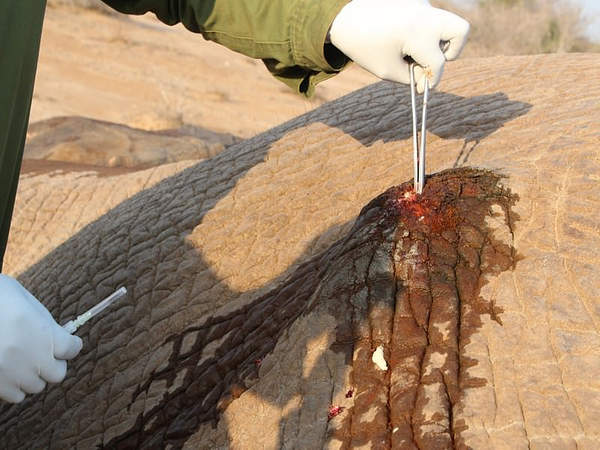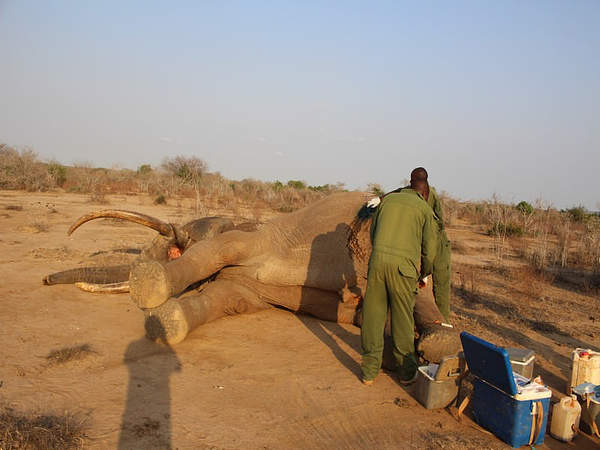The month of August saw a number of attempted poaching and human-wildlife conflict cases in the Tsavo region.
The Unit treated two young former elephant orphans at the Ithumba DSWT stockade, in northern Tsavo East, for injuries caused by lion attacks. In other cases, an elephant cow was treated at Lualenyi Ranch for non specific illness, while two other elephants were treated for arrow wounds near Dakota and Tiva River, both in Tsavo East. In Sobo area of Tsavo East National Park an injured elephant cow was euthanized after examination revealed an untreatable injury on her rump, while a problem leopard captured near Maungu was examined, treated and released back into the park.
CASE#1 TREATMENT OF AN ELEPHANT COW
Date: 4th August 2018
Species: Loxodanta Africana (African Elephant)
Sex: Female
Age: Adult
Location: Lumo conservancy, Tsavo
History: A report of a sickly looking elephant cow was received from a camp operator within Lualenyi Community Conservancy, which borders Tsavo West National Park. The Veterinary team visited the conservancy and found the sickly looking elephant under a tree with obvious signs of sickness but with no external wounds. The faecal droppings observed nearby were dry and hard indicating possible intestinal problems. Preparation was made to treat the Elephant.
Immobilization, examination and treatment: The elephant cow was approached by vehicle and darted using 16 mgs of Etorphine propelled by a dan inject dart system and went down after 6 minutes. The trunk and the ear were positioned correctly to aid in breathing and temperature control. She had no external wounds but examination revealed possible gastro-intestinal problems. Long acting antibiotics were administered intramuscularly and Dexamethasone Hcl was administered intravenously through a prominent ear vein.
Reversal and prognosis: The anaesthesia was reversed and prognosis for full recovery is guarded.
CASE#2 TREATMENT OF A FORMER ELEPHANT ORPHAN
Date: 5th August 2018
Species: Loxodanta Africana (African Elephant)
Sex: Female
Age: Sub-adult
Location: Ithumba, Tsavo East
History: The Team received a report of an injured elephant by the David Sheldrick Wildlife Trust at Ithumba in northern Tsavo East National Park. The former orphan had been allegedly attacked by lions roaming the area. There were extensive bite and puncture wounds all over the body of the Elephant.

Immobilization, examination and treatment: The elephant was approached on foot and darted using 10 mgs of Etorphine propelled in a dan inject dart system and the elephant went down after 5 minutes. The trunk and the ear were positioned correctly to aid in breathing and temperature control. There were extensive bite and purulent puncture wounds all over the body. The tail had a laceration at the base that severed the blood supply leading to ischemic necrosis of the tail.
The necrotic tail was amputated and all the wounds cleaned using Hydrogen Peroxide mixed with clean water, then doused with Tincture of Iodine and sprayed with Oxytetracycline spray. A coat of wetted green clay was used to cover the wounds for quicker healing. Long acting antibiotics were administered intramuscularly and Dexamethasone Hcl was administered intravenously through a prominent ear vein.
Reversal and prognosis: The anaesthesia was reversed by use of Diprenorphine at three times the Etorphine dose. The elephant stood up and prognosis for full recovery is good.
CASE#3 TREATMENT OF A FORMER ELEPHANT ORPHAN
Date: 18th August 2018
Species: Loxodanta Africana (African Elephant)
Sex: Male
Age: Sub-adult
Location: Ithumba, Tsavo East.
History: A report of another injured former elephant orphan that had been released back into the wild, by the David Sheldrick Wildlife Trust at Ithumba in northern Tsavo East National Park. He had been allegedly attacked by Lions roaming the area. There were extensive fresh bite wounds all over the body.

Immobilization, examination and treatment: The elephant was approached on foot and darted using 10 mgs of Etorphine in a 1.5 cc dart barrel and went down after 5 minutes. The trunk and the ear were positioned correctly to aid in breathing and water was poured onto his ear for temperature control. Examination revealed extensive bite wounds and lacerations on the body surface with serious ones on the left thigh and face that ruptured one of his eyes.
The wounds were cleaned using Hydrogen Peroxide mixed with clean water, then doused with Tincture of Iodine and sprayed with Oxytetracycline spray. A coat of wetted green clay was used to cover the wounds for quicker healing. Long acting antibiotics were administered intramuscularly and Dexamethasone Hcl was administered intravenously through a prominent ear vein.
Reversal and prognosis: The anaesthesia was reversed and the elephant stood up without struggling. The elephant is traumatized and should remain at the stockades for monitoring purposes. Prognosis for full recovery is good but with one eye blindness.
CASE#4 TREATMENT OF A BULL ELEPHANT
Date: 25th August 2018
Species: Loxodanta Africana (African Elephant)
Sex: Male
Age: Sub-adult
Location: Tiva River, Tsavo East
History: A report was made by DSWT desnaring Rangers who were patrolling the park along the Tiva River area together with KWS rangers of a young elephant bull with two fresh arrow wounds, which were bleeding. The teams kept watch over the injured elephant as the DSWT Helicopter picked the vet from Voi for faster attendance to the case.

Immobilization, examination and treatment: The elephant was easily found near the Tiva River as the rangers kept a close eye on it. The elephant was approached on foot and darted using 10 mgs of Etorphine propelled by a dan inject dart system and went down in 7 minutes after running briefly. Trees and twigs were cleared around the fallen elephant. Two fresh arrow wounds were observed on the left rump area with the arrowhead sticking out of one.
The arrowhead was removed and the wounds were cleaned using Hydrogen Peroxide mixed with clean water, then doused with Tincture of Iodine and sprayed with Oxytetracycline spray. A coat of wetted green clay was used to cover the wound for quicker healing. Long acting antibiotics were administered intramuscularly and Dexamethasone Hcl given intravenously through a prominent ear vein.
Reversal and prognosis: The anaesthesia was reversed and the elephant stood up after a couple of minutes. Prognosis for a full recovery is good.
Our Mobile Vet Units are in the field every day saving wild lives
CASE#5 EXAMINATION OF A PROBLEM LEOPARD
Date of intervention: 26th August 2018
Animal: Leopard
Species: Panthera pardus
Sex: Male
Age: Sub-adult
Location: Maungu, Tsavo East.
History: Complaints of livestock predation by wild carnivores from the Community living around Maungu area necessitated KWS to set up trap cages in the area to capture the problem wildlife.
Capture, treatment and translocation: A young male leopard was finally captured and brought to the Tsavo Vet Unit for examination. The leopard was given some meat and water. Observation indicated there was a problem with his mouth. He was immobilized the next day by darting with 100 mgs of Ketamine Hcl and 1 mg Meditomidine Hcl.
A piece of wood stuck on the upper palate was removed and the leopard was placed back into a cage to recover from the anaesthesia. Anaesthesia was reversed using Yohimbine. The Leopard recovered well and was released back into the expansive Tsavo East National Park.
CASE#6 TREATMENT OF AN ELEPHANT BULL
Date of intervention: 27th August 2018
Animal: Elephant
Species: Loxodanta Africana
Sex: Male
Age: Adult
Location: Dakota, Tsavo East National Park
History: Report of a huge elephant bull with arrow wound injuries was received from the DSWT aeroplane that was doing patrols along the Dakota Southern Park boundary. The bull was with several other big bulls. The vet team drove to the area and was joined by the DSWT Helicopter minutes later. The injured bull was easily spotted amongst the group.

Immobilization, examination and treatment: Darting accessories was prepared containing 18 mgs of Etorphine Hcl in a Dan inject dart system. The bull was approached using a chopper and darted on the rump using 18 mgs of Etorphine Hcl in a Dan inject dart system. He was kept in an open area by the chopper and went down after 9 minutes.
The trunk was well positioned for proper respiration. There was a wound on the left upper thigh near the pelvic region still oozing pus. The wound was cleaned using water mixed with Hydrogen Peroxide, then doused with Tincture of Iodine and sprayed with Oxytetetracycline antibiotic spray. The Elephant was deemed not to be in any threat from systemic infection and therefore was not given antibiotics.
Reversal and prognosis: Anaesthesia was reversed by use of Diprenorphine at 3 times the Etorphine dose. Prognosis for full recovery is very good.
CASE#7 EXAMINATION OF A RECUMBENT ELEPHANT COW
Date of intervention: 28th August 2018
Animal: Elephant
Species: Loxodanta Africana
Sex: Female
Age: Adult
Location: Tsavo East National Park
Introduction: The report was made by KWS rangers manning the Rhino platoon at Tsavo East National Park of an elephant cow that had fallen down and unable to stand up. The vet team rushed to area to find the elephant with an obvious wound at the back lying down in a River bed.

Treatment and autopsy: As the elephant was recumbent and the wound was at the back, there was no need for immobilization. The wound was cleaned and antimicrobials applied then covered in green clay. Systemic antibiotics and anti-inflammatory drugs were administered parenterally. Attempts were made to assist the elephant onto her feet several times in vain.

The cow was left overnight and visited the next day only to be found to have succumbed. An autopsy revealed she succumbed to an arrow injury at the back.
OTHER ACTIVITIES
The unit examined several wildlife trophies/parts brought in from Makindu and Voi.
Acknowledgement
Report by KWS Vet Dr Poghon. The unit acknowledges the support of its sponsors ViER PFOTEN through the David Sheldrick Wildlife Trust (DSWT) for their immense financial contribution to the unit. We also thank Kenya Wildlife Service through the Assistant director Tsavo conservation area and the head, veterinary and capture services department for their support.
